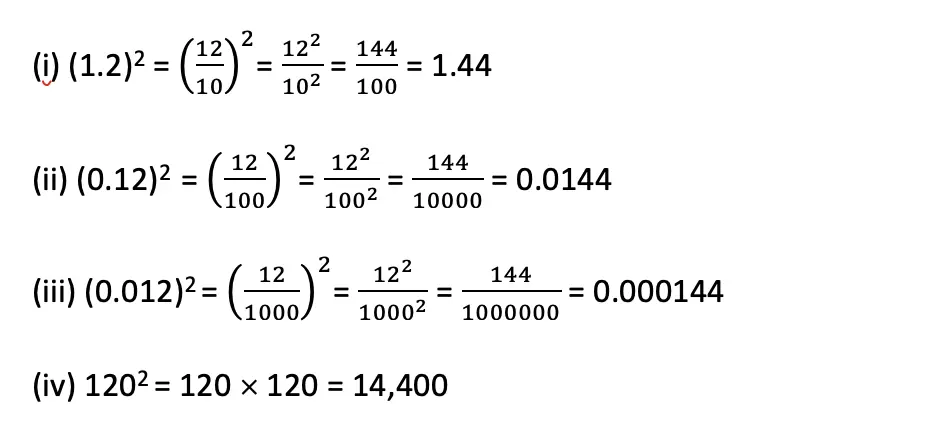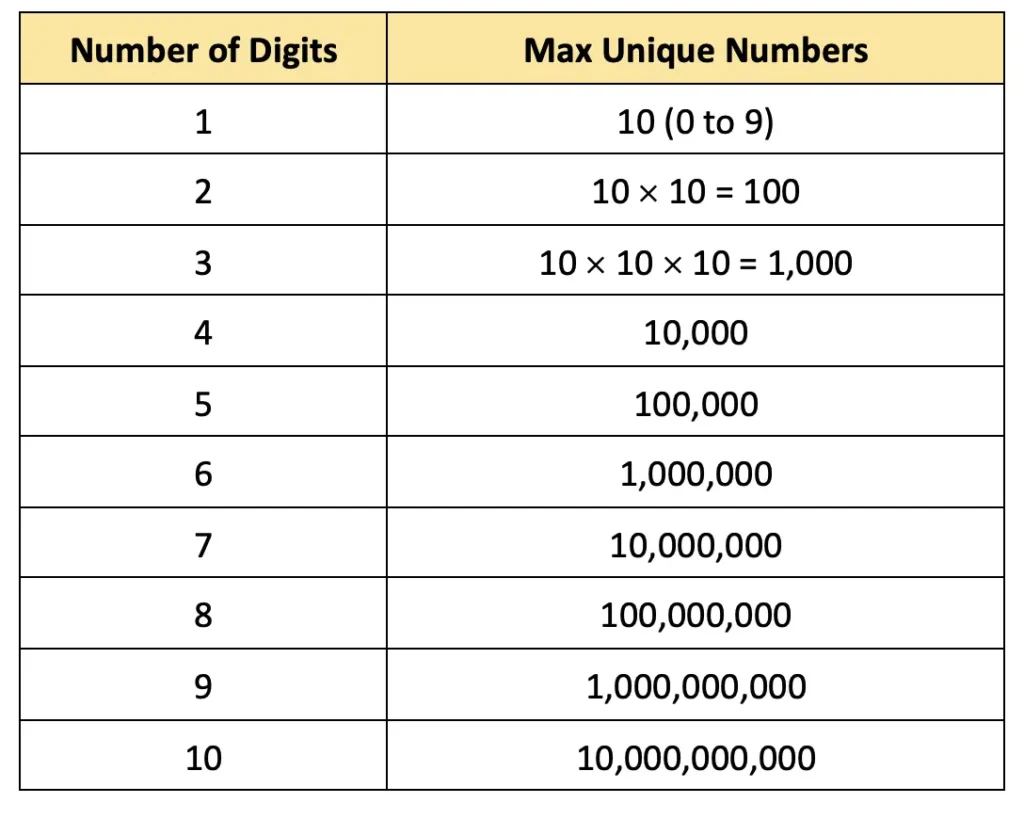Class 8 Maths Chapter 2 Power Play Ganita Prakash NCERT Solutions
Textbook Page 22 – 23
Figure it Out
1. Express the following in exponential form:
(i) 6 × 6 × 6 × 6
(ii) y × y
(iii) b × b × b × b
(iv) 5 × 5 × 7 × 7 × 7
(v) 2 × 2 × a × a
(vi) a × a × a × c × c × c × c × d
Solution:
(i) 6 × 6 × 6 × 6 = 64
(ii) y × y = y2
(iii) b × b × b × b = b4
(iv) 5 × 5 × 7 × 7 × 7 = 52 × 73.
(v) 2 × 2 × a × a = 22 × a2.
(vi) a × a × a × c × c × c × c × d = a3 × c4 × d.
2. Express each of the following as a product of powers of their prime factors in exponential form.
(i) 648 (ii) 405 (iii) 540 (iv) 3600
Solution:
(i) 648 = 2 × 2 × 2 × 3 × 3 × 3 × 3 = 23 × 34.
(ii) 405 = 3 × 3 × 3 × 3 × 5 = 34 × 5.
(iii) 540 = 2 × 2 × 3 × 3 × 3 × 5 = 22 × 33 × 5.
(iv) 3600 = 2 × 2 × 2 × 2 × 3 × 3 × 5 × 5 = 24 × 32 × 52.
3. Write the numerical value of each of the following:
(i) 2 × 103
(ii) 72 × 23
(iii) 3 × 44
(iv) (-3)2 × (-5)2
(v) 32 × 104
(vi) (-2)5 × (-10)6
Solution:
(i) 2 × 103
= 2 × (10 × 10 × 10)
= 2 × 1000
= 2000.
(ii) 72 × 23
= (7 × 7) × (2 × 2 × 2)
= 49 × 8
= 392.
(iii) 3 × 44
= 3 × (4 × 4 × 4 × 4)
= 3 × (16 × 16)
= 3 × 256
= 768.
(iv) 32 × 104
= {(-3) × (-3)} × {(-5) × (-5)}
= 9 × 25
= 225.
(v) 32 × 104
= (3 × 3) × (10 × 10 × 10 × 10)
= 9 × 10000
= 90000.
(vi) (-2)5 × (-10)6
= {(-2) × (-2) × (-2) × (-2) × (-2)} × {(-10) × (-10) × (-10) × (-10) × (-10) × (-10)}
= {4 × 4 × (-2)} × {100 × 100 × 100}
= (-32) × (1000000)
= -32000000.
Textbook Page 44 – 45
Figure it Out
1. Find out the units digit in the value of 2224 ÷ 432 ?
Solution:
2224 ÷ 432
= 2224 ÷ (22)32
= 2224 ÷ 22 × 32
= 2224 ÷ 264
= 2224 – 64 = 2160
21 = 2 (units digit 2)
22 = 4 (units digit 4)
23 = 8 (units digit 8)
24 = 16 (units digit 6)
25 = 32 (units digit 2)
26 = 64 (units digit 4)
27 = 128 (units digit 8)
………..
………..
Here, the pattern repeats after every 4 steps.
So, the unit’s digit of 2160 is the same as that of 24, which is 6.
2. There are 5 bottles in a container. Every day, a new container is brought in. How many bottles would be there after 40 days?
Solution:
Number of containers added every day = 1
Number of containers after 40 days = 40 containers
Number of bottles in a container = 5
Total bottles in 40 containers = 5 × 40 = 200 bottles
Therefore, there would be 200 bottles after 40 days.
3. Write the given number as the product of two or more powers in three different ways. The powers can be any integers.
(i) 643
(ii) 1928
(iii) 32-5
Solution:
(i) 643
64 = 2 × 2 × 2 × 2 × 2 × 2 = 26
643 = (26)3 = 218
Three different ways:
1. 643 = 218 = 29 × 29
2. 643 = 218 = 210 × 28
3. 643 = 218 = 26 × 26 × 26
(ii) 1928
192 = 2 × 2 × 2 × 2 × 2 × 2 × 3 = 26 × 3
1928 = (26 × 3)8 = 26 × 8 × 38 = 248 × 38
Three different ways:
1. 1928 = 248 × 38 = 240 × 28 × 38 = 240 × (2×3)8 = 240 × 68
2. 1928 = 248 × 38 = (224×34)×(224×34)
3. 1928 = 248 × 38 = (26)8 × 38
(iii) 32-5
32 = 2 × 2 × 2 × 2 × 2 = 25
32-5 = (25)-5 = 2-25
Three different ways:
1. 32-5 = 2-25 = 2-15 × 2-10
2. 32-5 = 2-25 = 2−5 × 2−5 × 2−5 × 2−5 × 2−5
3. 32-5 = 2-25 = 2-5 × 2-20
4. Examine each statement below and find out if it is ‘Always True’, ‘Only Sometimes True’, or ‘Never True’. Explain your reasoning.
(i) Cube numbers are also square numbers.
(ii) Fourth powers are also square numbers.
(iii) The fifth power of a number is divisible by the cube of that number.
(iv) The product of two cube numbers is a cube number.
(v) q46 is both a 4th power and a 6th power (q is a prime number).
Solution:
(i) Only sometimes true.
Explanation: 64 = 26 = (23)2 = (22)3 is both a cube and a square.
But 8 = 23 is a cube, not a square.
(ii) Always true.
Eplanation: 34 = (32)2 = 92.
54 = (52)2 = 252.
(iii) Always true.
Explanation: a5 = a3 × a2 and is divisible by a3.
(iv) Always true.
Explanation: 8 = 23, 27 = 33
8 × 27 = 216, which is 63.
(v) Never true.
Explanation: Since 46 is not divisible by 4 or 6. Therefore, there is no prime number q such that q46 is both a perfect fourth power and a perfect sixth power.
5. Simplify and write these in the exponential form.
(i) 10–2 × 10–5
(ii) 57 ÷ 54
(iii) 9–7 ÷ 94
(iv) (13–2)–3
(v) m5n12(mn)9
Solution:
(i) 10–2 × 10–5 = 10-2 – 5 = 10-7
(ii) 57 ÷ 54 = 57 – 4 = 53
(iii) 9–7 ÷ 94 = 9-7 + 4 = 9–3
(iv) (13–2)–3 = 13-2 × -3 = 136
(v) m5n12(mn)9 = m5n12 × m9n9 = m5+9n12+9 = m14n21
6. If 122 = 144 what is
(i) (1.2)2
(ii) (0.12)2
(iii) (0.012)2
(iv) 1202
Solution:

7. Circle the numbers that are the same —
24 × 36, 64 × 32, 610, 182 × 62, 624
Solution:
(i) 24 × 36
(ii) 64 × 32 = (2 × 3)4 × 32 = 24 × 34 × 32 = 24 × 36
(iii) 610 = (2 × 3)10 = 210 × 310
(iv) 182 × 62 = (2 × 3 × 3)2 × (2 × 3)2 = 22 × 32 × 32 × 22 × 32 = 24 × 36
(v) 624 = (2 × 3)24 = 224 × 324
Therefore, 24 × 36, 64 × 32, and 182 × 62 are the same.
8. Identify the greater number in each of the following —
(i) 43 or 34 (ii) 28 or 82 (iii) 1002 or 2100
Solution:
(i) 43 or 34
43 = 64 , 34 = 81
So, 34 is greater.
(ii) 28 or 82
28 = 256, 82 = 64
So, 28 is greater.
(iii) 1002 or 2100
1002 = 10,000
2100 = (210)10 = 102410, which is far greater than 10,000.
So, 2100 is greater than 1002.
9. A dairy plans to produce 8.5 billion packets of milk in a year. They want a unique ID (identifier) code for each packet. If they choose to use the digits 0–9, how many digits should the code consist of?
Solution:
8.5 billion = 8,500,000,000

Therefore, the code should contain at least 10 digits to get a unique ID for each packet.
10. 64 is a square number (82) and a cube number (43). Are there other numbers that are both squares and cubes? Is there a way to describe such numbers in general?
Solution:
Yes, there are other numbers that are both squares and cubes. For example:
729 = 93 (cube number) = 272 (perfect square)
4096 = 163 (cube number) = 642 (perfect square)
General Rule: The sixth power of any number (i.e., n6) is both a square and a cube. i.e.
16 = 1
26 = 64
36 = 729
46 = 4096
56 = 15,625
11. A digital locker has an alphanumeric (it can have both digits and letters) passcode of length 5. Some example codes are G89P0, 38098, BRJKW, and 003AZ. How many such codes are possible?
Solution:
Length of passcode = 5
Total choices of alphabets and letters for each slot = 26 + 10 = 36
Total possible codes = 36 × 36 × 36 × 36 × 36 = 365
12. The worldwide population of sheep (2024) is about 109, and that of goats is also about the same. What is the total population of sheep and goats?
(i) 209 (ii) 1011 (iii) 1010
(iv) 1018 (v) 2 × 109 (vi) 109 + 109
Solution:
Population of sheep = 109
Population of goats = 109
Total population of sheep and goats = 109 + 109 or 2 × 109
Therefore, (v) 2 × 109 and (vi) 109 + 109 are the correct answers.
13. Calculate and write the answer in scientific notation:
(i) If each person in the world had 30 pieces of clothing, find the total number of pieces of clothing.
(ii) There are about 100 million bee colonies in the world. Find the number of honeybees if each colony has about 50,000 bees.
(iii) The human body has about 38 trillion bacterial cells. Find the bacterial population residing in all humans in the world.
(iv) Total time spent eating in a lifetime in seconds.
Solution:
(i) Estimated world population: ≈ 8 billion = 8 × 109
Number of pieces of clothing each person had = 30 pieces
Total number of pieces of clothing = 8×109 × 30 = 2.4 × 1011
(ii) Number of bee colonies in the world = 100 million = 1×108
Number of bees in each colony = 50,000 = 5 × 104
Total number of honeybees = 1 × 108 × 5 × 104 = 5 × 1012
(iii) World population ≈ 8 × 109
Number of bacterial cells in human body = 38 trillion = 3.8 × 1013
Total bacterial population residing in all humans in the world = (3.8 × 1013)× (8 × 109) = 30.4 × 1022 = 3.04 × 1023
(iv) Average person’s lifespan = 80 years
Time spent eating daily = 1.5 hours
Total eating time per day in seconds = 1.5 × 3600 = 5400 seconds
Number of days in 80 years = 80 × 365 = 29,200
Total seconds spent eating in a lifetime in seconds = 5400 × 29,200 = 1.5768 × 108
14. What was the date 1 arab/1 billion seconds ago?
Solution:
1 billion seconds = 1,000,000,000 seconds
1,000,000,000 ÷ (60 × 60 × 24 × 365) = 31.71 years
31.71 years = 31 full years and 0.71 × 365 = 259 days
Today is: 28 July 2025
Subtracting 31 years → 28 July 1994
Going back 259 days from 28 July 1994 → 11 November 1993.
So, 1 billion seconds ago was November 11, 1993.
